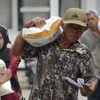Hanoi (VNA) – The heat index (HI) in nine areas of the Philippines was at “dangerous” level on April 15, according to the Philippine Atmospheric, Geophysical and Astronomical Services Administration (PAGASA).
The agency forecast that the harsh weather may last until May due to the impact of the El Nino phenomenon coinciding with the dry season in this Southeast Asian country.
PAGASA predicted that an HI at 43 degrees Celsius - a dangerous level - may occur in four locations, including Dagupan city (Pangasinan province), Aparri and Tuguegarao cities (Cagayan province) and Aborlan municipality (Palawan province). An HI at 42 degrees Celsius may occur in five other areas, including Echague (Isabela province), Puerto Princesa (Palawan), Roxas (Capiz), and Zamboanga and Cotabato cities.
Meanwhile, the HI, which indicates what the temperature feels like to the human body when relative humidity is factored in with the air temperature, is forecast to range from 39-40 degrees Celsius in Manila capital.
PAGASA said the "dangerous" HI is between 42 - 51 degrees Celsius, which can cause cramps, heat exhaustion, and even heat stroke. Meanwhile, the "extremely dangerous" HI level of 52 degrees Celsius or higher can cause immediate heat shock.
In light of these conditions, PAGASA advises the public to limit outdoor activities, especially during the noon hours, and stay hydrated by drinking plenty of water. Additionally, individuals venturing outdoors are urged to utilise umbrellas, hats, and clothing with sleeves for sun protection.
Earlier this month, Philippine education officials said that hundreds of schools in the country, including many in Manila, had to switch to online learning to ensure students' health due to hot weather./.
The agency forecast that the harsh weather may last until May due to the impact of the El Nino phenomenon coinciding with the dry season in this Southeast Asian country.
PAGASA predicted that an HI at 43 degrees Celsius - a dangerous level - may occur in four locations, including Dagupan city (Pangasinan province), Aparri and Tuguegarao cities (Cagayan province) and Aborlan municipality (Palawan province). An HI at 42 degrees Celsius may occur in five other areas, including Echague (Isabela province), Puerto Princesa (Palawan), Roxas (Capiz), and Zamboanga and Cotabato cities.
Meanwhile, the HI, which indicates what the temperature feels like to the human body when relative humidity is factored in with the air temperature, is forecast to range from 39-40 degrees Celsius in Manila capital.
PAGASA said the "dangerous" HI is between 42 - 51 degrees Celsius, which can cause cramps, heat exhaustion, and even heat stroke. Meanwhile, the "extremely dangerous" HI level of 52 degrees Celsius or higher can cause immediate heat shock.
In light of these conditions, PAGASA advises the public to limit outdoor activities, especially during the noon hours, and stay hydrated by drinking plenty of water. Additionally, individuals venturing outdoors are urged to utilise umbrellas, hats, and clothing with sleeves for sun protection.
Earlier this month, Philippine education officials said that hundreds of schools in the country, including many in Manila, had to switch to online learning to ensure students' health due to hot weather./.
VNA























